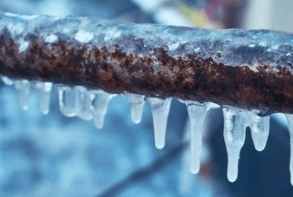Your basket is currently empty!
Written by
Frozen Condensate Pipe & How To Thaw It DIY Tips

Defrosting a Frozen Condensate Pipe

A condensate pipe captures heat from flue gases and ” recycles ” it back into the heating system to heat the water inside the boiler.
The condensate pipe drains the water produced during the condensing process in a condensing boiler, which can be up to 2 litres per hour for an efficient boiler.
The pipe is typically 22mm in diameter if the drainage system is connected internally, and 32mm if it is drained externally and is vulnerable to freezing in extremely low temperatures or prolonged cold spells
How to thaw a frozen boiler condensate pipe
Make sure to follow instructions carefully so as to not damage your boiler or cause any harm to yourself and potentially others.
Pour warm water over your condensate pipe
- Firstly, heat some water up in the kettle so that it can be poured over the condensate pipework. However, this shouldn’t be boiling water as you don’t want to damage the pipe.
- Carefully pour the water over the frozen pipe to melt the ice away. This can be directly from the kettle if the water isn’t boiling or from a jug if you allowed the water to cool first.
- Once it is unfrozen, restart your boiler.
Use a hot water bottle to unfreeze the pipe
Restart the boiler once it is unfrozen.y broken or in need of replacement, you just need to safely thaw your condensate pipe and your boiler should be up and running again in no time.
Pour warm water into a water bottle.
Place the bottle next to the frozen spot of your condensate pipe.
Boiler condensate pipe location

Before even knowing if your condensate pipe is frozen, you will need to locate it first to be able to inspect it. As we have said previously, the condensate pipe is an external component of your boiler and is usually located outside of your home.
It should be the only plastic pipe connected to your boiler and is usually either white or grey. A condensate pipe should be connected to your boiler at one end and to some form of external drain pipe at the other, so the waste water can be safely drained from your system.
How to know if your condensate pipe has frozen
There are some signs that you can look out for if you suspect you have a frozen pipe, which will occur under cold temperatures, causing the freeze. One of the most prominent indications that you have a frozen boiler condensate pipe is you may hear a gurgling noise coming from your boiler. T
hese gurgling noises will usually mean that your boiler has shut down as a precaution, meaning it is important to listen out for these noises.
In fact, this is a feature in almost all condensing boilers, so if you notice that your boiler has stopped working and you have a complete lack of hot water, this may be one of the causes.
When condensate pipes do get a frozen section, a fault code will usually appear on the boiler’s display to let you know that something is wrong. Not all fault codes mean the same thing, so it is also important that you look out for certain ones that suggest frozen condensate pipes.
Get the best quotes for boiler installation online in under 1 minute now
New Gas Boilers with FREE Hive Mini Smart Thermostat!
£0 Deposit & 0% Interest Finance available
Frozen condensate pipe error codes
There are many different boiler brands out there which have a range of fault codes signalling that there is an issue with your boiler. Each manufacturer will have different fault codes for a condensate pipe freezing, so we will let you know the most common ones to look out for from some of the top boiler brands.
Some of the codes to look for are:

- Viessmann F2
- Worcester Bosch EA 227
- Worcester Bosch EA 229
- Vaillant F29
- Worcester Bosch EA 224
- Ideal L2
- Vaillant F28
How to prevent frozen condensate pipes in the future
Now that you have managed to unfreeze your condensate pipe, there are a few ways to prevent the condensate pipe from freezing moving forward. Taking these preventive measures can end up saving you a lot of trouble, especially during low temperatures.
Insulate your pipes
During the Winter, it is important to protect and keep your condensate pipe warm to reduce the chances of it freezing again. One way of protection is to add a layer of foam pipe insulation around your condensate pipe, which will not only keep it warm but will also prevent the condensate pipe from freezing.

Move the condensate pipe
If you live in an area that can get quite cold and have to deal with condensate pipes freezing a lot, then you might want to consider moving your pipe. Moving it so that it is in a place with a higher temperature such as making it internal to your home, will be a big step towards no longer having frozen pipes.
Change the pipe’s fall angle
Changing the pipe’s fall angle so that water flow increases is another method to stop freezing. With an increased water flow, it should much faster through the pipe meaning less water will get collected in the joints of the pipe and, therefore, reduces the chances of freezing.
To do this, however, you will likely need a heating engineer to change the angle, as this isn’t something that is easily done.

Increase heating system temperature
Another option that you could consider is turning up the temperature of your boiler and your system, as the higher temperature of the water should make it harder for the water to freeze. However, this will also likely increase heating bills, so this should really be a last resort.
Get the best quotes for boiler installation online in under 1 minute now
New Gas Boilers with FREE Hive Mini Smart Thermostat!
£0 Deposit & 0% Interest Finance available
Written by
Get the best quotes for boiler installation online in under 1 minute now
New Gas Boilers with FREE Hive Mini Smart Thermostat!
£0 Deposit & 0% Interest Finance available





